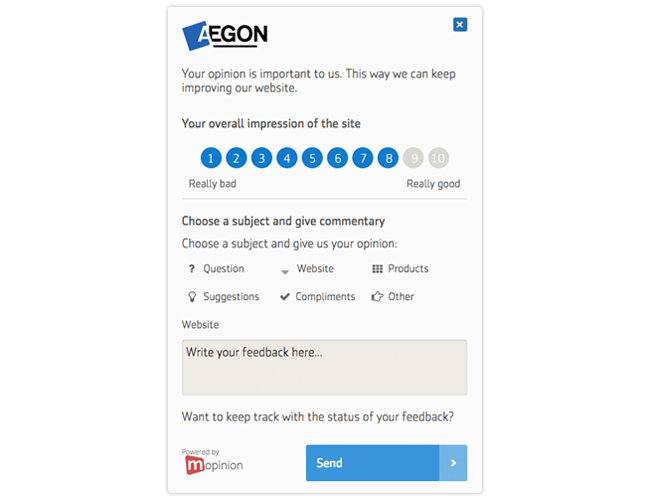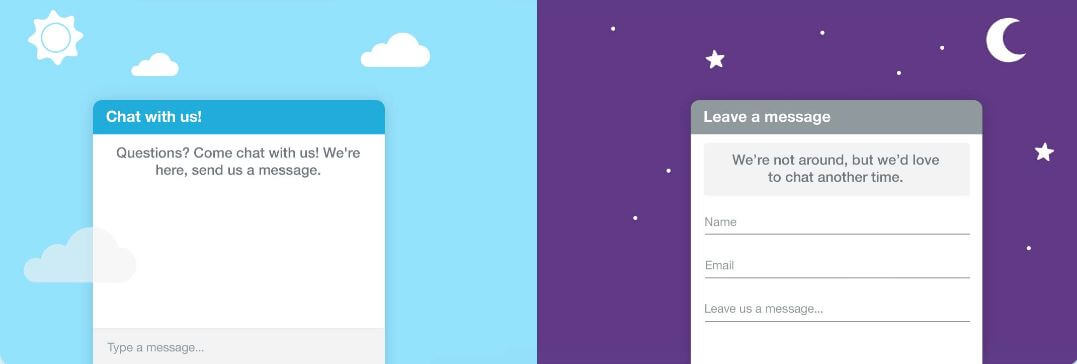Ask anyone. There are many companies out there that make use of several tools as a means for communicating with their visitors or customers on their website, be it through a chatbot, feedback form or direct review. Now, you might be thinking ‘Hey these are basically classified as customer experience tools and I have one!’ and because you already utilise one of these tools, there is nothing else you need to do to improve the customer experience. Well that’s not entirely true…
In this blog we will take a closer look at three website tools and give you a sense of which is best for your company. Things to consider: are you looking to drive conversions, build trust among your customers, provide service for your customers online, or perhaps capture insights on why your visitors are unable to achieve their goals? Keep your goals in mind whilst reading.
So let’s start with my favourite!
Feedback forms
Feedback forms come in all shapes and sizes. A very popular method of data collection, feedback forms provide marketers with a way of retrieving insights deep within the order and service funnels of their websites and mobile apps.
- Collect unlimited feedback
- ■
- Free 14 day trial
But what is a feedback form?
Typically in the form of a feedback button, these are usually situated on the side or at the bottom of the web page. However, they can also appear automatically as an overlay (modal) after being triggered based on click or browsing behaviour. For example – if a visitor leaves an ordering page. See previous blog on passive vs. active feedback forms for further explanation on these two types of feedback forms.
The feedback forms themselves often comprise of a number of elements: a score (e.g. a star-rating, NPS or Customer Satisfaction score), a number of feedback categories (e.g. “bug”, “compliment”, “spelling mistake”) and the option of making an open comment.

When to use a feedback form?
If your company uses its website as the first point of contact for selling your products/services, it is likely that you also keep track of the amount of visitors on your site. You probably do this with Google Analytics (GA) which is the industry standard for tracking, analysing, and reporting quantitative data. GA measures the ‘what’, and feedback forms tell you ‘why’ – straight from the visitors mouth.
If you have answered ‘no’ to any of these, you need a feedback form:
- Do you know why your customers are abandoning their shopping carts on your website?
- Do you know why certain product pages have more sales than others?
- Do you know how many technical issues are costing you sales?
- Do you know what your company’s average Net Promoter Score is?
- Do you have any idea if your customers had successful website visits?
- Do you know if your customers are returning customers or new customers?
- Do you know how your visitors are experiencing your website or what they really think of your brand?

Conclusion
Feedback forms are insightful when you’re looking to understand why visitors behave the way they do and should always be the one tool you have first when you have a website. Feedback forms extract valuable and actionable insights from your collected responses that enable you to spot problems or opportunities before it’s too late.
Chat tools
You see them everywhere these days. Chat tools have increased in popularity over the years as they enable customers to communicate with your brand on their own time and own terms, via one-on-one contact with your agents.

Image: Olark
But what is a chat tool?
Chat tools are those chat boxes on websites asking you if you would like to contact an agent and ask questions in real-time. Often these tools have the capability to store customer data in the company’s CRM system, enabling the company to keep track and monitor chat sessions.
Similar to these chat tools, there are also tools known as chatbots. Commonly known as AI (Artificial Intelligence) systems, these bots respond to a user’s questions as if you were having a conversation with them.
When to use a chat tool?
Chat tools can be used on the website in a number of different ways. Similar to feedback forms, there are proactive chat tools and reactive chat tools. Proactive chat tools are triggered by pre-defined business rules, e.g. in the event that the customer is having trouble on the website. Alternatively, reactive chat is initiated by the customer via ‘click-to-chat’ button. This is the more passive approach.
As for chatbots – they can work around the clock for no extra charge, whereas humans must be paid for every hour they work, regardless of the level of traffic. This approach is becoming increasingly popular but the fact remains that the majority of companies are using chat tools.
If you have answered ‘yes’ to these, you need a chat bot:
- Do you want to allow some form of customer service online to ensure that your visitors are not alone and have a way of communicating with someone conversationally?
- Do you have data sources for the products or services that you want to provide?
- Do you have existing customer inquiries / questions in any format, stored in your CRM database or as emails?

Image: Zopim
Conclusion
Live chat-boxes are useful from a live customer service perspective, but not so much from an insight and experience improvement standpoint. Chat alone is also short-term and related to helping one person with an issue which may take up valuable time from your service team. It is not always available 24/7 especially during after-work hours.
Feedback is loosely defined as learning from user experience and then resolving the issue through insights collected and preventing said issue from affecting the experience in the long-run. That being said, chat tools complement feedback forms. If we detect that a user shares feedback and reports a bug then we could redirect him/her immediately to a chat agent.
Examples of chat tools: Olark, Snapengage, Zopim
Consumer Web Reviews
According to Econsultancy, nearly 61% of customers read online reviews before making a purchase decision and they are now essential for ecommerce sites. Customer reviews are proven sales drivers, as they are what the majority of customers will want to see before deciding to make a purchase.
But what are consumer web reviews?
These are frequently used among web shops as well as hotel and travel industries. With this type of tool you can send the customer an invitation via email asking them to leave an evaluation after buying a product. If you click on the invitation you are taken to a review form. The assessment often takes the form of a star rating from 1 to 5 and an open comment field. Here people can indicate how satisfied they are with the purchase.
Reviews can also contribute positively to SEO conversions. If review content is properly formatted, it can increase Click-through-rates (CTR) on search results pages. Additionally, reviews can improve rankings in long-tail searches. Not to mention more than half of all consumers allow themselves to be influenced by online reviews.

Image: Trustpilot
When to use consumer web reviews?
The question with this sort of tool is often whether it really is a good idea for marketers to show the ratings and qualitative input from customers. The answer to this varies between industries – whether your company is a hotel, airline, utility company, etc. While having great reviews about your company helps customers increase conversions, you’re also welcoming negative reviews. And more often than not people get influenced by negativity.
Additionally, with reviews it is difficult to gauge if a visitor has left your web page as the result of a negative review – there is no way of preventing them from leaving and helping them convert. To solve this, what you could do is complement them with a feedback form on the review page that is triggered after a person has left the webpage.
If you have answered ‘yes’ to these, you need consumer web review
- Do you want a way for customers to leave feedback after they purchase a product that is publicly displayed?
- Are you using this to drive SEO and online conversions?
- Do you want to discover what customers think of your products, listen to your customers to address issues, attract new customers and most importantly, build trust and increase sales?
- Do you want to respond to these customers?

Conclusion
Consumer reviews are best used when you want people to come to your website and get a feel for which types of products work best for them. Web reviews are more of a vanity tool than anything. If implemented well, web reviews can complement feedback forms in finding out if your visitors are influenced by certain things mentioned in the reviews that trigger them to purchase or stop them from purchasing.
Examples of online review communities: Feefo, Trustpilot, eKomi
Check here for a full list of ecommerce rating and review tools.
Start improving your CX
As you can see, each of these tools has something different to offer in terms of collecting valuable Voice of the Customer data and optimising CX. So don’t sell yourself short. Get started using one or more of these tools and see what it can do for you and your customers.
Ready to see Mopinion in action?
Want to learn more about Mopinion’s all-in-1 user feedback platform? Don’t be shy and take our software for a spin! Do you prefer it a bit more personal? Just book a demo. One of our feedback pro’s will guide you through the software and answer any questions you may have.








